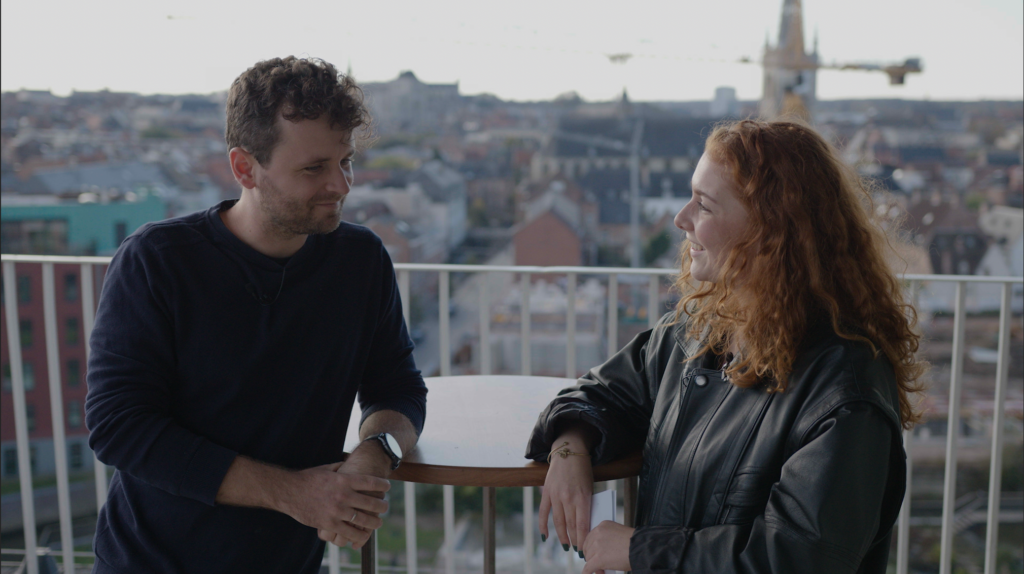No need for a VPN or specific rights to be assigned, no need to create 50 accounts,… You just got one TinkerList login and you can work from anywhere.
Frederik vandput
Hi Frederik
Hi Rosanne
How are you?
Very good, I’m happy to be in Leuven where I was born and raised.
Thank you for coming all the way to the TinkerList office.
No worries.
We invited you to talk about TinkerList and how you implement it in your job. Could you describe for us what you do?
I am system engineer media support at VRT. The goal is that I help people with their media related problems and questions. This can be in the ‘idea’ phase, in the production or post production phase,… and uh, TinkerList is a part of that, especially in the production phase.
So your work is quite diverse? You have various responsibilities?
Every day is something else… So that’s nice!
How varied are the used software and technologies at VRT?
Extremely varied! There’s a huge software package used at VRT. And that’s a challenge sometimes. Different productions work in different ways and we noticed that since we use TinkerList -it started off really small- colleagues gradually apply the software in other productions. In that way TinkerList-use expands at VRT and everyone starts using the same tools. It’s really cool.
I can imagine that it must be a challenge to manage this. How do you do that, day per day?
How do we do this? We see day per day (laughs)
So we have a ‘ticketing system’: we talk to people, we get emails, phone calls,… We don’t really have a fixed way of solving problems and answering questions. Case per case, we look at how we’re going to fix things. I can’t really draw a continuous line through that so… But that makes it interesting!
What’s the biggest challenge for you in your job?
The biggest challenge? Uhhh I think… making sure that my colleagues can practice their job in the most comfortable way possible. And there are so many tools within VRT that they get overwhelmed sometimes of what they have to do and what routes they have to take to acquire a good result. The hardest part is to get everyone on the same track to the same destination.
How do you stay patient with people that know very little
about technology? How do you handle that?
The most important thing is to remind yourself that it is your job and not your private life. (laughs) It can be frustrating at times but that’s also the case for those people. You just have to remember that we’re all working together towards the same result and everyone makes up a piece of that puzzle. Sometimes people have specific problems but then it’s our job to smooth them out or to search for solutions and yeah… We never know on beforehand what the solution is.
That keeps it interesting?
Definitely.
You mentioned earlier that TinkerList is used at VRT, for what type of productions exactly?
TinkerList is used for all types of productions nowadays: fiction, studio,… It’s really broad. Now they’re creating a webstudio to do lives with TinkerList… So yeah… TinkerList is used for all types of productions within VRT. I mean television and online productions.
At VRT, you try to use as much in-house tools and similar tools as possible, how do you feel about outsourcing this responsibility to TinkerList?
That’s not always as easy because from a business point of view they ask us: “How is it going with TinkerList? What are the problems with TinkerList?”, and then we can’t immediately give the right answer. The support of TinkerList is really good and really fast and the end users at VRT are really happy with that, but it’s not always clear for us what exactly is happening in that way. So we try to ask our colleagues: “How is TinkerList going? How are you working with it?” Because uhh… It’s not always easy to verify this.
People at VRT have already asked me if I own shares of TinkerList as I’m always the one during meetings that suggests to use it. (laughs)
fREDERIK VANDEPUT
What’s the biggest added value of TinkerList in your opinion?
The added value is that TinkerList is such an ‘all-in-one package” for productions. One production works with Onedrive the other with Google Drive, another one with word documents and another one with a joint network share… And the advantage of TinkerList is that all the different tools are integrated in one package and integrated over different productions. Because it can be a challenge for my colleagues to use different tools for different productions in different ways. And with TinkerList, everyone works more or less the same way.
So is that how you would recommend TinkerList?
Yeah definitely! Because uhh… People at VRT have already asked me if I own shares of TinkerList as I’m always the one during meetings that suggests to use it. (laughs) Sometimes they’re like “But I don’t know that yet” or they ask for a demo so yeah I’m giving TinkerList demos now… It all started really small for me at VRT but now I give demos and trainings! (laughs)
What’s the big advantage of a cloud-based tool vs an on-premise tool?
I think the biggest advantage is the cooperation with one another. On top of that, as we use very heavy tools, software and archives at VRT, it is very challenging for our laptops to process them all simultaneously. But with an online tool such as TinkerList, anyone with internet access can work easily.
How would you compare television before and after TinkerList?
Before TinkerList, a production was very chaotic with some kind of structure for those who know it. But if you’re an outsider that just joined the production team, then that’ll be a lot to process in order to work along. Whilst with TinkerList, you just get a ‘login’, just click around and you see what happens. The trainings are also minimal: one or two hours of training and most people are all set.
I can only be positive about the usability because many different profiles work with TinkerList: for example a cameraman doesn’t need to see the same thing as a producer or editor and the ‘view’ can be adapted to what’s relevant for the user.
FREDerik vandeput
How user-friendly is TinkerList?
I can only be positive about the usability because many different profiles work with TinkerList: for example a cameraman doesn’t need to see the same thing as a producer or editor and the ‘view’ can be adapted to what’s relevant for the user.
Which feedback do you get from users?
The feedback is only positive… Not much of negative critique… The positive word-of-mouth proves that as well.
Would you have some constructive feedback for us to do better in the future?
That’s a really hard question and I think that’s a good sign. (laughs) It would be nice if the tool would be implemented even more at VRT so everyone would work the same way across productions.
How do you think television production will evolve in the future?
Corona changed a lot in the production process, we had to work from home and I think that will stay except for the filming itself, which has to happen on location. But in the production phase, a lot of ‘working from home’ is possible and that’s another advantage of TinkerList that is cloud-based: everyone with an internet connection can do their work. No need for a VPN or specific rights to be assigned, no need to create 50 accounts,… You just got one TinkerList login and you can work from anywhere. So the evolution is working more from home and TinkerList fits in that picture.
Merci Frederik to swing by and to answer our questions.
My pleasure.

